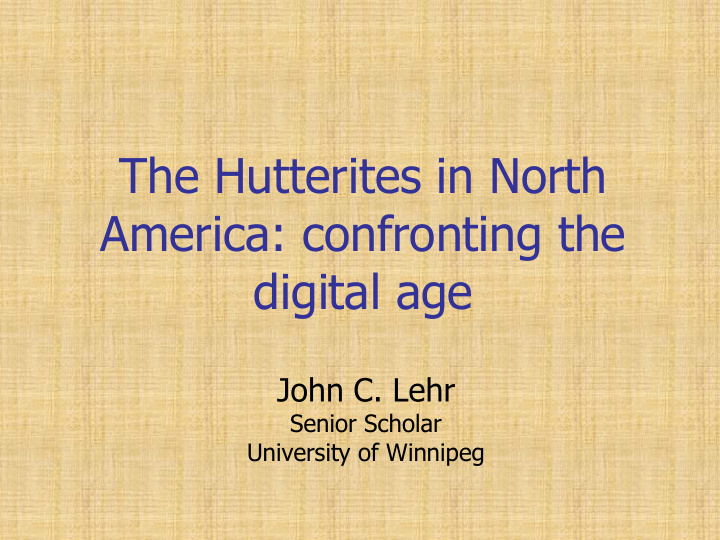



The Hutterites in North America: confronting the digital age John C. Lehr Senior Scholar University of Winnipeg
Who are the Hutterites? German-speaking pacifist Anabaptists Belief in “Community of goods.” A product of the Reformation in Europe Persecuted for their beliefs Carinthia Ukraine United States of America (1874-6) Canada 1918-19
Hutterite migrations in Europe
Hutterite Surnames Entz 1. Glanzer 2. Gross 3. Since migration Hofer 4. to the New World Kleinsasser 5. Maendel very few (if any) 6. Stahl have joined and 7. Tschetter remained in the 8. Waldner 9. community. Walter 10. Wipf 11. Decker 12. Wollman 13. Wurz 14.
The leute Lehrerleut [regarded as the most conservative leut] Dariusleut Schmiedeleut [regarded as the most liberal leut] - since mid 1990s Group 1 (More liberal “ Kleinsasser ” colonies) Group 2 (More conservative colonies)
The Hutterite colony Has about 70-150 people (10-12 families) Usually relies on agriculture. Most farm between 5000 – 8500 acres Family units reside separately but live, eat and work communally.
Starlight Colony, Manitoba
James Valley Colony
Maxwell colony, Manitoba
Crystal Spring Colony, Manitoba
Houses are single family homes Hillcrest (Dariusleut) James Valley (Schmiedeleut)
The Hutterite colony: Is seen by Hutterites as an Ark in a secular and sinful sea. Thus the colony seeks social and physical isolation from the world Total isolation is not possible but partial isolation was achieved Provides for all needs: food, clothing, meals and accommodations when travelling, etc. Schmiedeleut members receive a $3.00 monthly allowance for discretionary spending, Dariusleut get $20.00 but no meal allowance when off the colony.
The Regulations and Conference Letters from 1772 until the Present Time • Only pertain to the Schmiedeleut. • Written in (High) German
Ordnungen und Konferenz Briefen 28 December 2007
And there are theological concerns too The taking of pictures is also being practiced as if it were permitted, and it is practiced without thought or shyness, although God has strictly forbidden it and all those who overstep this, overstep God’s order and cannot escape unscathed. Ordnungen und Konferenz Briefen 27 December 2007
Strategies for social isolation Language Dress codes Colony locations Rural Screened from view Away from major highways Seldom signed (never officially) Not named on Canadian topographic maps although named on US maps.
Dress A kind of uniform that separates them from the “English” Represents Hutterite values Varies between the leute Changes only slowly
Women’s dress (Schmiedeleut)
Male clothing (Schmiedeleut) No belts. No back pockets No buttons No zippers
Expansion One of the world’s highest birthrates Colonies become dysfunctional when population exceeds available jobs Expansion brings conflict with the outside world: Land Resentment by established “English” populations
Threats to the Hutterites Pressure to conform Anglo Conformity Military service Allegations that they ruin rural communities English rapidly adopted by most Assimilation the goal of mainstream society
A genealogy of James Valley Elie, MB colony branching 1918 Riverdale Riverdale Spring Valley Miami Starlite Starlite Gladstone, MB Gladstone, MB Brandon, MB Miami, MB Starbuck, MB Starbuck, MB 1946 1946 1956 1966 1991 1991 Deerboine Holmfield Wellwood Green Acres Green Acres Sky View Alexander, MB Killarney, MB Ninette, MB Wawanesa, MB Wawanesa, MB Miami, MB 1959 1975 1967 1991 1991 1993 Oak River Oak River, MB 1998
Legal barriers to expansion. Alberta’s Communal Property Act (1943 -72 Land sales to enemy aliens or Hutterites forbidden No new colonies within 40 miles of any colony No colony of more than 6,400 acres Discharged soldiers have right of first refusal Manitoba’s “gentleman’s agreement.” (1957 -69) New colonies’ lands limited to 5.120 acres No more than two colonies in any one municipality A distance of at least 10 miles between colonies Saskatchewan’s “gentleman’s agreement.”(1958 -68) No new colonies within 35 miles of any colony No colony of more than 10,000 acres Social and economic needs of local communities come first
Problems with mainstream society Community resistance Fear of alien dominance Lack of interest in assimilation by Hutterites seen as major contrast with other ethnic groups Legislated barriers Alberta Communal Property Act Manitoba “Gentlemen’s Agreement .” Saskatchewan’s “Gentlemen’s Agreement.”
New threats with Multiculturalism After 1967 -- Multiculturalism Policy: Change in attitudes creates new problems for Hutterites More difficult to retain separation from mainstream society The communications revolution Easier penetration of secular values
The greatest threat Evangelical churches offer promise of personal salvation without communal living. Defection rates increasing because of the easier transition to the outside world More ex-Hutterites in outside world. \defectors more likely to have outside contacts to help Oil industry needs labour with Hutterite skill sets Most who leave link up with ex-Hutterites or join similar Christian institutions that offer a sense of community
A simple life . . .
That embraces agricultural technology Hutterite agriculture is highly mechanized. Their industries employ cutting edge technology
Colonies are now moving into industry • High land prices. • Agricultural quotas. • Low returns on agricultural investment. • Limited job opportunities with mechanized agriculture.
Gender and democracy • Work is gendered: women in the domestic sphere; men in agriculture/industry. • Only baptized men can vote on colony affairs. • Nature of work redresses this imbalance to some extent.
The digital revolution Threatens Hutterites’ separation from the outside world Radio, television, cellphones and internet access offer easy penetration of secular values into the colony Access to cellphones and internet is necessary to conduct business in the modern world Sales representatives offer inducements: hockey and football game tickets, liquor, restaurant meals, cash kickbacks etc.
Cell phones now commonly used • Cell phones are now allowed – if they do not have a camera. • Some colonies issue cell phones on a “sign out as needed” basis. • I-phones are not officially allowed on most colonies. • BUT – many have them. • Implications?
Questions?
Answers: Yossi Katz and John Lehr, Inside the Ark: the Hutterites in Canada and the United States, (2 nd Edition) Regina: University of Regina Press, 2014. ISBN 978-0-88977-358-5 (pbk)
Recommend
More recommend